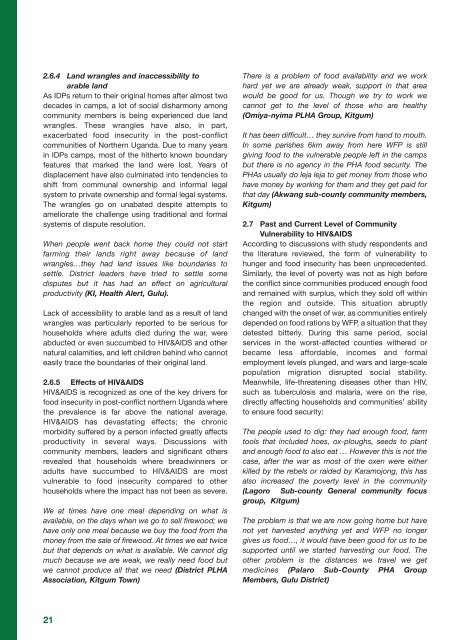Uganda Report 2012 FINAL PO:Layout 1 - ACORD
Uganda Report 2012 FINAL PO:Layout 1 - ACORD
Uganda Report 2012 FINAL PO:Layout 1 - ACORD
You also want an ePaper? Increase the reach of your titles
YUMPU automatically turns print PDFs into web optimized ePapers that Google loves.
2.6.4 Land wrangles and inaccessibility to<br />
arable land<br />
As IDPs return to their original homes after almost two<br />
decades in camps, a lot of social disharmony among<br />
community members is being experienced due land<br />
wrangles. These wrangles have also, in part,<br />
exacerbated food insecurity in the post-conflict<br />
communities of Northern <strong>Uganda</strong>. Due to many years<br />
in IDPs camps, most of the hitherto known boundary<br />
features that marked the land were lost. Years of<br />
displacement have also culminated into tendencies to<br />
shift from communal ownership and informal legal<br />
system to private ownership and formal legal systems.<br />
The wrangles go on unabated despite attempts to<br />
ameliorate the challenge using traditional and formal<br />
systems of dispute resolution.<br />
When people went back home they could not start<br />
farming their lands right away because of land<br />
wrangles…they had land issues like boundaries to<br />
settle. District leaders have tried to settle some<br />
disputes but it has had an effect on agricultural<br />
productivity (KI, Health Alert, Gulu).<br />
Lack of accessibility to arable land as a result of land<br />
wrangles was particularly reported to be serious for<br />
households where adults died during the war, were<br />
abducted or even succumbed to HIV&AIDS and other<br />
natural calamities, and left children behind who cannot<br />
easily trace the boundaries of their original land.<br />
2.6.5 Effects of HIV&AIDS<br />
HIV&AIDS is recognized as one of the key drivers for<br />
food insecurity in post-conflict northern <strong>Uganda</strong> where<br />
the prevalence is far above the national average.<br />
HIV&AIDS has devastating effects; the chronic<br />
morbidity suffered by a person infected greatly affects<br />
productivity in several ways. Discussions with<br />
community members, leaders and significant others<br />
revealed that households where breadwinners or<br />
adults have succumbed to HIV&AIDS are most<br />
vulnerable to food insecurity compared to other<br />
households where the impact has not been as severe.<br />
We at times have one meal depending on what is<br />
available, on the days when we go to sell firewood; we<br />
have only one meal because we buy the food from the<br />
money from the sale of firewood. At times we eat twice<br />
but that depends on what is available. We cannot dig<br />
much because we are weak, we really need food but<br />
we cannot produce all that we need (District PLHA<br />
Association, Kitgum Town)<br />
There is a problem of food availability and we work<br />
hard yet we are already weak, support in that area<br />
would be good for us. Though we try to work we<br />
cannot get to the level of those who are healthy<br />
(Omiya-nyima PLHA Group, Kitgum)<br />
It has been difficult… they survive from hand to mouth.<br />
In some parishes 6km away from here WFP is still<br />
giving food to the vulnerable people left in the camps<br />
but there is no agency in the PHA food security. The<br />
PHAs usually do leja leja to get money from those who<br />
have money by working for them and they get paid for<br />
that day (Akwang sub-county community members,<br />
Kitgum)<br />
2.7 Past and Current Level of Community<br />
Vulnerability to HIV&AIDS<br />
According to discussions with study respondents and<br />
the literature reviewed, the form of vulnerability to<br />
hunger and food insecurity has been unprecedented.<br />
Similarly, the level of poverty was not as high before<br />
the conflict since communities produced enough food<br />
and remained with surplus, which they sold off within<br />
the region and outside. This situation abruptly<br />
changed with the onset of war, as communities entirely<br />
depended on food rations by WFP, a situation that they<br />
detested bitterly. During this same period, social<br />
services in the worst-affected counties withered or<br />
became less affordable, incomes and formal<br />
employment levels plunged, and wars and large-scale<br />
population migration disrupted social stability.<br />
Meanwhile, life-threatening diseases other than HIV,<br />
such as tuberculosis and malaria, were on the rise,<br />
directly affecting households and communities’ ability<br />
to ensure food security:<br />
The people used to dig: they had enough food, farm<br />
tools that included hoes, ox-ploughs, seeds to plant<br />
and enough food to also eat … However this is not the<br />
case, after the war as most of the oxen were either<br />
killed by the rebels or raided by Karamojong, this has<br />
also increased the poverty level in the community<br />
(Lagoro Sub-county General community focus<br />
group, Kitgum)<br />
The problem is that we are now going home but have<br />
not yet harvested anything yet and WFP no longer<br />
gives us food…, it would have been good for us to be<br />
supported until we started harvesting our food. The<br />
other problem is the distances we travel we get<br />
medicines (Palaro Sub-County PHA Group<br />
Members, Gulu District)<br />
21





